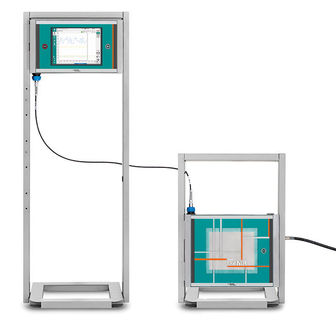| Bone: Foramen spinosum of Sphenoid
|
|
|
| Sphenoid bone. Upper surface. (foramen spinosum labeled left, second from bottom.)
|
|
|
| Base of the skull. Upper surface. (Sphenoid is yellow, and foramen spinosum is at bottom right of sphenoid.)
|
| Gray's
| subject #35 150
|
| Dorlands/Elsevier
| f_12/12373713
|
The foramen spinosum is one of several foramina located in the base of the skull, on the sphenoid bone, situated lateral to the foramen ovale, in a posterior angle.
Contents
It permits the passage of certain arteries, veins and/or other structures:
- the middle meningeal artery
- a recurrent branch, the nervus spinosus, from the mandibular nerve (the mandibular nerve is the third branch (V3) of the trigeminal nerve)
Morphology and morphometry
The foramen may be absent (in approx. 2% of the cases), in which case the middle meningeal artery enters the cranial cavity through the foramen ovale.[1]
The foramen spinosum and ovale may be continuous, and the foramen spinosum may be duplicated. Wood-Jones (1931) found the foramen spinosum to be more or less incomplete in approx. 44% of the cases. The foramen spinosum was small or altogether absent in 0.4% of Lindblom's (1936) cases. This is especially true when the middle meningeal artery arises from the ophthalmic artery (the foramen would be near to empty in that case). In rare cases, early division of the middle meningeal artery into a posterior and anterior division may result in a duplication of the foramen spinosum.[1]
In the newborn, the foramen spinosum is about 2.25 mm and in the adults about 2.56 mm in length. The width of the foramen extends from 1.05 mm to about 2.1 mm in the adults.[2] The average diameter of the foramen spinosum is 2.63 mm in the adult.[3]
The earliest perfect ring-shaped formation of the foramen spinosum was observed in the 8th month after birth and the latest in 7 years after birth in a developmental study on the foramen rotundum, foramen ovale and foramen spinosum. The majority of the foramen in the skulls studies was round in shape.[3] Ginsberg et al. (see reference below) observed asymmetry of size in 16% of their patients.
In a study under 123 CT studies, Ginsberg, Pruett, Chen and Elster did not find an inverse relationship between the size of the foramen spinosum and that of the foramen ovale (for instance, a smaller foramen spinosum did not correlate with the size of the foramen ovale).[4]
References
- ^ a b Illustrated Encyclopedia of Human Anatomic Variation: Opus V: Skeletal Systems: Cranium - Sphenoid Bone. Illustrated Encyclopedia of Human Anatomic Variation. Retrieved on 2006-04-10.
- ^ Lang J, Maier R, Schafhauser O (1984). "Postnatal enlargement of the foramina rotundum, ovale et spinosum and their topographical changes". Anatomischer Anzeiger 156 (5): 351-87. PMID 6486466.
- ^ a b Yanagi S (1987). "Developmental studies on the foramen rotundum, foramen ovale and foramen spinosum of the human sphenoid bone". The Hokkaido Journal of Medical Science 62 (3): 485-96. PMID 3610040.
- ^ Ginsberg LE, Pruett SW, Chen MY, Elster AD (February 1994). "Skull-base foramina of the middle cranial fossa: reassessment of normal variation with high-resolution CT". Americal Journal of Neuroradiology 15 (2): 283-91. PMID 8192074.
See also
Additional images
This article was originally based on an entry from a public domain edition of Gray's Anatomy. As such, some of the information contained herein may be outdated. Please edit the article if this is the case, and feel free to remove this notice when it is no longer relevant.
| Bones of head and neck: the cranium |
|---|
| Occipital | Foramen magnum - Squama occipitalis (Inion - Nuchal lines - Planum occipitale - Planum nuchale - Cruciform eminence - Internal occipital protuberance - Sagittal sulcus - Internal occipital crest)
Lateral parts (Occipital condyle - Hypoglossal canal - Condyloid fossa - Condylar canal - Jugular process - Jugular tubercle) - Basilar part (Pharyngeal tubercle) |
|---|
| Parietal | Parietal eminence - Temporal line - Parietal foramen |
|---|
| Frontal | Squama frontalis (Frontal suture - Frontal eminence - Superciliary arches - Glabella - Supraorbital foramen - Zygomatic process - Sagittal sulcus - Frontal crest - Foramen cecum) - Pars orbitalis (Ethmoidal notch - Lacrimal fossa - Trochlear fovea - Posterior ethmoidal foramen - Anterior ethmoidal foramen - Frontal sinus - Frontonasal duct) |
|---|
| Temporal | Squama temporalis (Articular tubercle - Suprameatal triangle - Mandibular fossa - Petrotympanic fissure) - Mastoid portion (Mastoid foramen - Mastoid process - Mastoid notch - Occipital groove - Sigmoid sulcus - Mastoid antrum) - Petrous portion (Facial canal - Hiatus of the facial canal - Internal auditory meatus - Subarcuate fossa - Carotid canal - Aqueduct of cochlea - Jugular fossa - Inferior tympanic canaliculus - Mastoid canaliculus - Styloid process - Stylomastoid foramen - Petrosquamous suture) - Tympanic part (Suprameatal spine) - Zygomatic process |
|---|
| Sphenoid | Body Superior surface (Ethmoidal spine, Chiasmatic groove, Optic foramen, Sella turcica, Fossa hypophyseos, Middle clinoid process, Dorsum sellae, Posterior clinoid processes, Petrosal process, Clivus) - Lateral surface (Carotid groove - Sphenoidal lingula) - Anterior surface (Sphenoidal sinuses) - Great wings (Spine, Foramen rotundum, Foramen ovale, Foramen Vesalii, Foramen spinosum, Infratemporal crest, Sulcus tubae auditivae) - Small wings (Superior orbital fissure, Anterior clinoid process, Optic foramen) - Pterygoid processes (Pterygoid fossa, Scaphoid fossa, Lateral pterygoid plate, Medial pterygoid plate, Pterygoid canal, Pterygoid hamulus) - Sphenoidal conchae |
|---|
| Ethmoid | Cribriform plate (Crista galli) - Perpendicular plate - Labyrinth (Ethmoid sinus) - Lateral surface Lamina papyracea - Uncinate process - Medial surface Middle nasal concha - Superior meatus - Superior nasal concha - Middle meatus |
|---|
| Foramina of the skull (and canals and fissures) |
|---|
| Foramina | cecum - ethmoidal (anterior, posterior) - incisive - jugular - lacerum - magnum - mandibular - mastoid - mental - optic - orbital (infraorbital, supraorbital) - ovale - palatine (greater, lesser) - parietal - rotundum - sphenopalatine - spinosum - stylomastoid - zygomaticofacial - zygomaticotemporal |
|---|
| Canals | carotid - condylar - hypoglossal - incisive - pterygoid |
|---|
| Fissures | orbital (inferior, superior) - petrotympanic |
|---|
| other | external acoustic meatus - internal acoustic meatus - cribriform plate |
|---|
|







